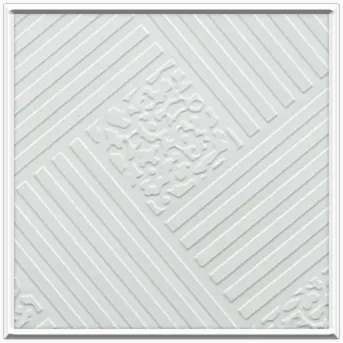- Afrikaans
- Albanian
- Amharic
- Arabic
- Armenian
- Azerbaijani
- Basque
- Belarusian
- Bengali
- Bosnian
- Bulgarian
- Catalan
- Cebuano
- Corsican
- Croatian
- Czech
- Danish
- Dutch
- English
- Esperanto
- Estonian
- French
- German
- Greek
- Hindi
- Indonesian
- irish
- Italian
- Japanese
- Korean
- Lao
- Malay
- Myanmar
- Norwegian
- Norwegian
- Polish
- Portuguese
- Romanian
- Russian
- Serbian
- Spanish
- Swedish
- Thai
- Turkish
- Ukrainian
- Uzbek
- Vietnamese
stu . 27, 2024 03:00 Back to list
Exploring the Concept of Ceiling in T-Bar Construction and Design Techniques
The Ceiling T-Bar An Essential Component in Modern Construction
In the world of modern construction and interior design, the ceiling T-bar system has become an essential component, revolutionizing how spaces are structured and finished. This innovative approach not only enhances the aesthetics of a room but also serves practical purposes in terms of insulation, soundproofing, and easy access to utilities.
Understanding the Ceiling T-Bar System
A ceiling T-bar, also known as a suspended ceiling grid, is a framework used to support ceiling panels. It consists of metal channels arranged in a grid pattern, resembling the letter 'T' when viewed. The horizontal and vertical components allow for the easy placement of ceiling tiles, which can be made from various materials, including mineral fiber, fiberglass, and even metal.
The T-bar system is typically suspended from the overhead structural components, providing a clean and sleek appearance while allowing for the concealment of wiring, plumbing, and ductwork. This leads to a neater environment, where essential utilities do not compromise the aesthetic value of the space.
Benefits of Using T-Bar Ceilings
1. Aesthetic Appeal One of the primary reasons designers and builders choose T-bar systems is their capacity to enhance the visual appeal of a space. They are versatile enough to accommodate different styles, from sleek modern looks to more traditional designs. With a variety of tile finishes and colors available, it becomes easier to match the ceiling with the overall theme of the room.
2. Acoustic Control T-bar ceilings are often favored for their soundproofing capabilities. The materials used in ceiling tiles can significantly impact the acoustics of a room, with options available that absorb sound and reduce echo. This is particularly useful in commercial spaces like offices and conference rooms, where clear communication is paramount.
ceiling t bar

3. Easy Access to Utilities One of the standout features of suspended T-bar ceilings is the ease of access they provide to electrical wiring, plumbing, and HVAC systems. Tiles can be removed without the need for extensive deconstruction, allowing for quick maintenance and repairs. This accessibility can save both time and money in the long run, as issues can be addressed promptly.
4. Thermal Insulation Many ceiling tiles offer thermal insulation properties, helping maintain the desired temperature in a room. This can lead to energy savings, as heating and cooling systems do not have to work as hard to maintain comfort levels. It’s a win-win situation, benefiting both the environment and reducing utility costs.
5. Fire Resistance Safety is a primary concern in any construction project, and T-bar ceilings can contribute significantly to fire resistance. Many ceiling tiles are treated with fire-retardant chemicals or are made from fire-resistant materials. This not only provides extra safety for occupants but also helps in meeting local building codes and insurance requirements.
Installation and Maintenance
Installing a ceiling T-bar system is relatively straightforward, which can be one of its greatest advantages. Many DIY enthusiasts choose to undertake this project, thanks to the availability of comprehensive guides and kits. However, for larger commercial spaces, hiring a professional can ensure the installation is done correctly.
Maintenance is also minimal, requiring occasional cleaning of the tiles to remove dust and debris. In the event of damage, individual tiles can be easily replaced without needing to dismantle the entire ceiling, making it a practical choice for a long-term solution.
Conclusion
The ceiling T-bar system is more than just a functional element in construction; it is a versatile design feature that offers numerous benefits. From enhancing the aesthetics of a space to improving acoustic performance and providing easy access to essential utilities, T-bar ceilings have revolutionized the way we think about interior spaces. As architects and designers continue to seek innovative ways to maximize functionality while maintaining beauty, the suspended ceiling T-bar will undoubtedly remain a vital component in the architecture of tomorrow. Whether in homes, offices, or commercial settings, the ceiling T-bar stands as a testament to the intersection of functionality and design.
-
Transform Interiors with PVC Gypsum Ceiling: A Stylish, Durable, and Moisture-Resistant SolutionNewsMay.19,2025
-
The Smart Interior Upgrade: Discover the Durability and Versatility of Gypsum Ceiling Access Panel SolutionsNewsMay.19,2025
-
The Smart Choice for Interior Design: Discover the Value of PVC Gypsum Ceiling SolutionsNewsMay.19,2025
-
Mineral Fiber Ceiling Tiles: The Smart Blend of Performance and AestheticsNewsMay.19,2025
-
Mineral Fiber Ceiling Tiles: The Superior Choice Over Gypsum for Sound and Fire SafetyNewsMay.19,2025
-
Mineral Fiber Ceiling Tiles: Eco-Friendly Strength and Style for Every CeilingNewsMay.19,2025







